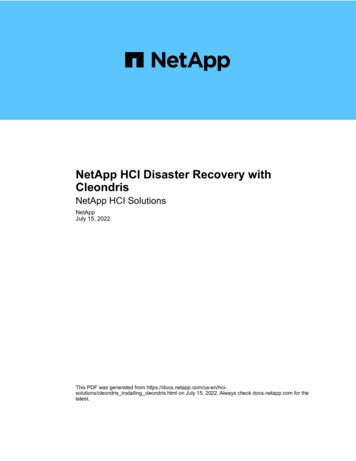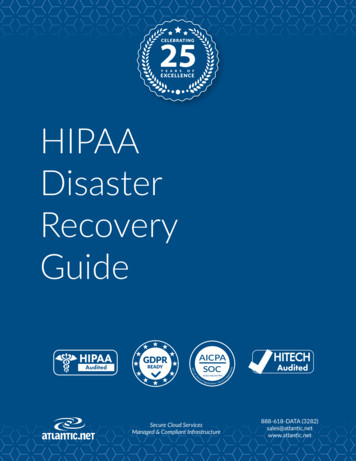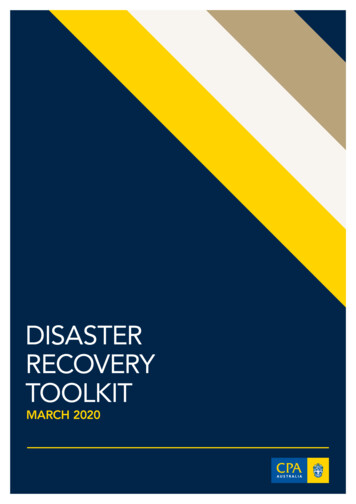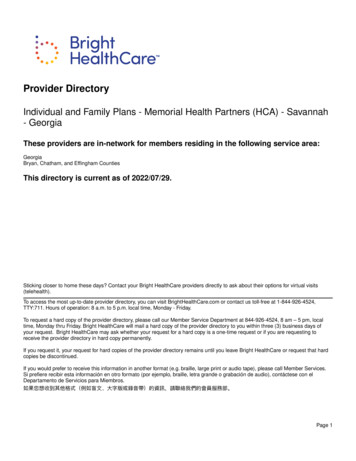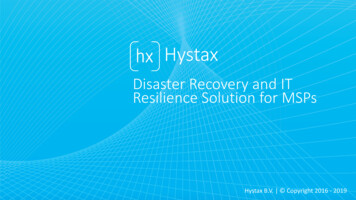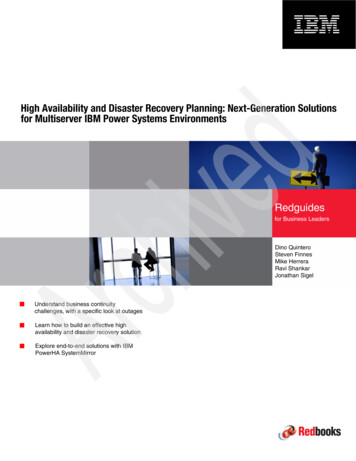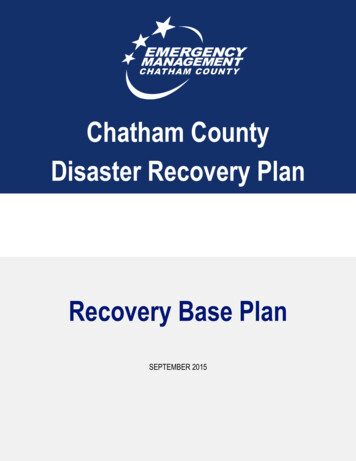
Transcription
Chatham CountyDisaster Recovery PlanRecovery Base PlanSEPTEMBER 2015
CHATHAM COUNTY – DISASTER RECOVERY PLANCHATHAM COUNTY DISASTER RECOVERY PLANSIGNATURE OF ADOPTIONThis document was adopted in accordance with federal, state, and local guidelinesregarding disaster recovery and coordination practices. The document was developed toensure safe and methodical recovery from incidents affecting populations in ChathamCounty. By signature, the entities below accept this document as a standard practice fordisaster recovery coordination.DateChairman, Chatham County Board of CommissionersDateMayor, City of BloomingdaleDateMayor, Garden CityDateMayor, City of PoolerDateMayor, City of Port WentworthDateMayor, City of SavannahDateMayor, Town of ThunderboltDateMayor, City of Tybee IslandPage 2 of 91September 2015
CHATHAM COUNTY – DISASTER RECOVERY PLANTABLE OF CONTENTSCHATHAM COUNTY DISASTER RECOVERY PLANSignature of Adoption22RECORD OF CHANGES5CHAPTER I - INTRODUCTION6PurposeScopeApplicabilityDisaster Recovery ProcessResponse to Recovery TransitionRecovery TimeframesDisaster Recovery GoalsPre-Disaster GoalsPost-Disaster Goals78881010111112CHAPTER II – SITUATION AND ASSUMPTIONS16SituationAssumptions1616CHAPTER III – CONCEPTS OF OPERATIONS19OverviewRecovery OrganizationCommand Policy GroupLocal Disaster Recovery ManagerRecovery CommitteeRecovery Liaison OfficerRecovery Legal OfficerRecovery Safety OfficerRecovery Public Information OfficerRecovery Operations SectionRecovery Planning SectionRecovery Logistics SectionRecovery Finance SectionRecovery Support Functions and GroupsState Disaster Recovery CoordinatorFederal Disaster Recovery CoordinatorRecovery Sites and FacilitiesRecovery ObjectivesRecovery OperationsShort-Term Recovery OperationsIntermediate-Term Recovery OperationsLong-Term Recovery 1921212222222223232323242426262627282930303030Page 3 of 91September 2015
CHATHAM COUNTY – DISASTER RECOVERY PLANCHAPTER IV – ROLES & RESPONSIBILITIES32General Roles and ResponsibilitiesIndividuals and HouseholdsLocal GovernmentsState GovernmentFederal GovernmentNon-governmental and Volunteer OrganizationsPrivate SectorSpecific Roles and ResponsibilitiesChairman of the Chatham County CommissionMunicipal Elected OfficialsCEMA DirectorCommand Policy GroupLocal Disaster Recovery ManagerRecovery CommitteeRecovery LiaisonRecovery Safety OfficerRecovery Public Information OfficerRecovery Operations SectionRecovery Planning SectionRecovery Logistics SectionRecovery Finance SectionRecovery Support FunctionsState Disaster Recovery CoordinatorFederal Disaster Recovery 040404141CHAPTER V – POLICIES AND PROCEDURES42CHAPTER VI - PLAN MANAGEMENT AND MAINTENANCE44ACRONYMS AND DEFINITIONS45AUTHORITIES AND REFERENCES49FederalStateCountyOther Guidance49505050APPENDICES51Appendix A – Establishing A Local Disaster Recovery CenterAppendix B – Finance SectionAppendix C – CEMA Checklists and SOPs527187Page 4 of 91September 2015
CHATHAM COUNTY – DISASTER RECOVERY PLANRECORD OF CHANGESChange NumberPage 5 of 91SectionDate of ChangeIndividual MakingChangeDescription of ChangeSeptember 2015
CHATHAM COUNTY – DISASTER RECOVERY PLANCHAPTER I - INTRODUCTIONThis Chatham County Disaster Recovery Plan (DRP) is developed for use by localgovernments, and partners in the public, private, and nonprofit sectors to facilitate recoveryfrom emergencies causing significant impact to infrastructure, housing, the economy, andthe health, social, cultural, historic and environmental framework of the community. ThisRecovery Plan is an all-hazards document to establish a comprehensive plan for managingrecovery efforts within the municipal and county governments located in Chatham County.For the purposes of this Recovery Plan, the definition of “recovery” aligns with the NationalDisaster Recovery Framework’s (NDRF) definition, described as:Those capabilities necessary to assist communities affected by an incident torecover effectively, including, but not limited to, rebuilding infrastructuresystems; providing adequate interim and long-term housing for survivors;restoring health, social, and community services; promoting economicdevelopment; and restoring natural and cultural resources.This plan is designed to identify potential actions required and the assistance necessary tosupport the recovery of the municipal and county governments located in Chatham Countywhen a disaster occurs requiring long-term recovery of the County, its agencies, and/ormunicipalities. It includes Recovery Support Function (RSF) Annexes to facilitate an efficientrecovery organization and operation.Response and recovery operations will begin and end at the local government level. Thisplan recognizes local governments are primarily responsible for response and recoveryoperations, and recovery will occur at the direction of the local community. Localgovernments have the capability and responsibility to conduct and support recoveryoperations following a disaster or emergency, and at the core of the recovery effort is thepreparation and planning implemented by the local community itself. County assistanceshall be provided upon request when the overall need exceeds the capability of localgovernment. State assistance shall be provided upon the request of County government.Federal assistance is supplemental to and requested by the State.The Plan is compatible and aligns with the principles established in the Georgia DisasterRecovery and Redevelopment Plan (GDRRP) and the NDRF. Where discrepancies in theGDRRP and NDRF exist, Chatham County’s DRP aligns with the GDRRP and then theNDRF.The Recovery Plan is designed to accomplish:Page 6 of 91September 2015
CHATHAM COUNTY – DISASTER RECOVERY PLAN A timely restoration, strengthening, and revitalization of critical infrastructure and housing;The resumption of a sustainable economy; andThe long-term recovery of key health, social, cultural, historic, and environmental components ofChatham County.This plan is only a starting point; it illustrates how assistance will be coordinated at thecounty and local level, but ultimately, the strength of a community’s recovery is directlycorrelated to the recovery planning conducted in each jurisdiction before an incident occurs.This document augments the Chatham County Emergency Operations Plan (EOP) byoutlining the responsibilities and actions of government agencies and other public andprivate entities involved in disaster recovery. It is supplemented by the Chatham CountyRedevelopment Plan (Redevelopment Plan), which guides planning, action, and decisionmaking during the long-term recovery period. The Redevelopment Plan also details actionspossibly taken place before a disaster to speed redevelopment.PURPOSEThe Recovery Plan provides the framework for Chatham County Emergency ManagementAgency (CEMA) in coordination with local, state, federal government agencies, and nongovernmental organizations to coordinate the federal, state, local, and private sectorrecovery from the long-term consequences of a disaster affecting part or all of ChathamCounty. The purpose of the Recovery Plan is two-fold: 1) to outline a framework potentiallyused to assist communities in rebuilding after a disaster while increasing the communities’ability to recover from future disasters, and 2) to provide the coordination necessary for theCounty and local governments to itself recover.The goal of recovery is to return populations, infrastructure, and natural and culturalresources to pre-disaster or better conditions as quickly as possible following a disaster.This Recovery Plan provides organizations involved in recovery with resources andoperational guidance to recover from emergencies causing significant impact toinfrastructure, housing, the economy, and the health, social, cultural, historic andenvironmental framework of the community.This Recovery Plan will outline partners’ activities and organization to promote recoveryfrom an incident. Activities required to respond to an incident are identified in localgovernment EOPs as well as the County EOP.Page 7 of 91September 2015
CHATHAM COUNTY – DISASTER RECOVERY PLANSCOPEThis plan provides guidance to Chatham County, its municipal jurisdictions, and partners inthe public, private, and nonprofit sectors, following major and catastrophic disasters. Itidentifies tasks for key agencies and organizations, as well as for coordinating andsupporting agencies in RSF roles. This plan should be used as a guiding document duringthe recovery phase of an event, and includes considers for preparedness actions to supportthat recovery. Response phase activities are identified and outlined in the county and localEOPs.The Recovery Plan is not a tactical plan or field manual. By focusing on strategic levels, thisplan provides a flexible and scalable framework for organization and provides decisionmaking tools that may be effectively deployed against unknown and unpredictable threats.This plan intentionally does not provide specific or qualitative thresholds for activation ordemobilization of organizational structures and/or processes described herein. Suchdeterminations are left to the judgment of government leaders, based on the capability tomanage disaster recovery at a given time.APPLICABILITYThe concepts and principles of the Recovery Plan may apply to any incident, whethernatural or human-caused, which may have recovery consequences, whether or not it resultsin a Presidential Disaster Declaration or Governor’s State of Emergency. In addition, it isimportant to recognize not all of the plan’s elements will be activated for every incident.DISASTER RECOVERY PROCESSThe recovery process is best described as a sequence of interdependent and oftenconcurrent activities progressively advancing a community toward a successful recovery.Decisions made and priorities set early in the recovery process, by a community, will have apositive cascading effect on the nature and speed of the recovery progress. In fact,decisions made before a disaster can also positively impact recovery. Figure 1 belowindicates how preparedness, response, and recovery functions are related.Page 8 of 91September 2015
CHATHAM COUNTY – DISASTER RECOVERY PLANFigure 1: Recovery ContinuumPage 9 of 91September 2015
CHATHAM COUNTY – DISASTER RECOVERY PLANRESPONSE TO RECOVERY TRANSITIONA) The transition from response to recovery is a gradual process, the pace and timing of whichwill depend on the circumstances. As response activities diminish, recovery activities willincrease.B) If the scope of the disaster dictates, a Recovery Committee will be established to managerecovery operations. The EOC Manager and Planning Section Chief will assess the need for aseparate recovery organization based on the impacts of the incident, in collaboration with theother ESFs, and will make a recommendation to the CEMA Director to activate the RecoveryPlan. The CEMA Director will then make a recommendation to the Command Policy Group(CPG) who will activate the Recovery Plan.ResponseShort-Term RecoveryIntermediate-TermRecoveryLong-Term RecoveryIncidentContainedNoMostly or CompletelyYesYesLife SafetyIssuesYesIn some areasNoNoContain theincident to protectlife-safety andpropertyA few days, atmost a few weeksProvide support topeople and businessesimpacted by thedisasterTransition to selfsufficient,sustainable, andfunctional stateRestoration of servicesreturning the community apre-disaster, or better,conditionDays to weeksWeeks to monthsMonths to yearsOverall GoalsDurationAfter IncidentTable 1. Response vs. Recovery ComparisonRECOVERY TIMEFRAMESA) Since emergency management is a cycle, there will be overlap between response andrecovery operations. Additionally, recovery operations for multiple events may take placesimultaneously.B) Recovery includes short-term, intermediate-term, and long-term phases.i.Short-term recovery concerns include managing and containing immediate impacts ofan event on community systems and beginning to return these systems back tooperating standards.ii.Intermediate-term recovery involves returning individuals and families, criticalinfrastructure, and essential government or commercial services back to a functionalstate, although not necessarily to a pre-disaster state.iii.Long-term recovery works to return to “near normal” conditions after a disaster oremergency, including restoring economic activity and rebuilding community facilitiesand housing. Long-term recovery can take several months or years.Page 10 of 91September 2015
CHATHAM COUNTY – DISASTER RECOVERY PLANDISASTER RECOVERY GOALSPRE-DISASTER GOALSThe following are goals guiding ongoing pre-disaster activities intended to result in thedevelopment of a full recovery readiness capability. Each goal is mapped to the appropriatesection of the Recovery Plan.GoalDescriptionEstablish and maintain an inventory of critical capabilities, assets, and resources(including local and County government, partners, and stakeholders).Identify appropriate legal authorities, triggers, and safeguards, such that criticalgovernmental and non-governmental functions and activities can be executedwith maximum efficiency.Educate elected officials and policy makers on priorities and decision-makingprocesses which support transparent and credible allocation of resources.Be prepared andproactive.Establish relationships with public and private stakeholders who are key to therecovery process.Establish and maintain an understanding of state and federal recovery fundingresources.Pre-identify resources, providers, and restoration and reconstruction priorities.Identify codes and ordinances relevant to recovery, and uncover gaps andneeds.Coordinate withlocal jurisdictions.Ensure the County is coordinating with local jurisdictions and recovery planningis synchronized. The County will support planning efforts in local jurisdictions.Establish andmaintain theCounty’s leadershiprole.The County will be responsible for defining and executing its own recovery andwill establish its leadership role in such a way it can integrate into federal, state,local, and regional recovery efforts and access external funding streams.Leverage existingrelationships withThe private and nonprofit stakeholders are critical in acquiring, managing, anddistributing resources, advancing economic recovery and development, andPage 11 of 91September 2015
CHATHAM COUNTY – DISASTER RECOVERY PLANGoalDescriptionprivate andnonprofit sectors.supporting other key disaster recovery functions. Some of these roles will beconsistent with day-to-day activities and responsibilities and others may makecontributions and out of the ordinary commitments. The County will provideleadership and participate to match needs to providers and to reduce resourceoverlaps and gaps.Promote legitimacyand credibility.To be effective, post-disaster recovery implementation must be characterized bytransparency, community participation, and intense stakeholder outreach andinvolvement. Community partners are crucial to ensuring two-way informationboth prior to and after a disaster, and they are also in a position to “champion”elements of recovery. These community partners help to balance long-termcommunity gains through economic development, mitigation, and social andcultural enhancements with the short-term well-being of residents.Focus on fairness.Individuals and organizations with the slimmest reserves prior to the disaster interms of preparedness, income, and/or capital reserves, as well as social andorganizational networks will be the most vulnerable after a disaster. The Countyis committed to pre- and post-disaster recovery work and intends to fairly andtransparently resolve competing, legitimate interests among diverse communityorganizations and economic drivers.Build on existingdeliberative plansand assetidentification/prioritization.To ensure legitimacy of prioritization, resource allocation, and programmanagement, the pre- and post-disaster decision making will be based onexisting deliberative plans and policies whenever possible.Ensure sufficientfinancial reserves.Disasters often place immediate financial pressures on affected areas. Not allcosts will be reimbursed and when they are, there is a very lengthy delay. Forthis reason, the availability of sufficient financial resources, be it in the form ofbudgeted reserves or the pre-event establishment of emergency lines of credit,will be extremely important.POST-DISASTER GOALSThe following are post-disaster operational goals intended to guide the leadership,coordination, and implementation of recovery measures.GoalPage 12 of 91DescriptionSeptember 2015
CHATHAM COUNTY – DISASTER RECOVERY PLANGoalProvide effectivecommand andcoordination.DescriptionThe Recovery Plan will guide the establishment and continuity of coordinated,effective, flexible, scalable, and responsive command and coordination. Anorganized transition of command structures from response to recovery will allowemergency management functions to evolve smoothly and for recovery work tobegin even while the basic life-safety, incident stabilization, and immediateproperty protection issues are still being addressed.During recovery, the expertise of planners, engineers, and financial professionalsin fields such as land use, economic development, transportation, storm watermanagement, capital projects, etc. will become increasingly important, and theroles of first responders revert back to their day-to-day functions.Maximize fundingopportunities.Recovery leadership will work to leverage state and federal recovery technicaland financial assistance, as well as identify and pursue additional sources ofrecovery funding and financing.Communicateeffectively.The County will strive to communicate useful, practical, relevant, accurate, andtimely information regarding services and resources to impacted communitiesand residents. Public communication should be coordinated with localjurisdictions and with the State and Federal Governments, through the Joint FieldOffice (JFO), when established.Promote mitigationand foster resilientredevelopment andconstruction.The County and local jurisdictions will use education, incentives, and regulationto reduce community vulnerability to various hazards by fostering more resilientland use patterns and building practices while deferring to existing deliberativeplans such as EOPs and Hazard Mitigation Plans and leveraging existingprograms.Page 13 of 91September 2015
CHATHAM COUNTY – DISASTER RECOVERY PLANGoalDescriptionMaintenance and/or restoration of the economic base is vital to the localeconomic health. This focus includes business continuity, maintenance ofbusiness-critical infrastructure systems, supply chains, and social services, andproactive business, recruitment and retention strategies by recognizing newmarkets, new expertise, and new opportunities will be created by crises. Suchefforts will extend beyond the economic sector, involving “catalyst” projectsdesigned to simultaneously advance social, environmental, cultural, andeconomic recovery goalsMaintain andenhance theCounty’s economicbase.Businesses and employers will have varying levels of operational capability aftera disaster. Concerted efforts will be made by local leadership to retain corebusinesses and to support their recovery. After a disaster, the local and Countygovernments will support area businesses by clearing obstacles to recovery,including assisting in facilitating staffing, supporting relocation if needed, andhelping to resolve supply-chain issues.The private sector will play a critical role in maintaining public confidence after adisaster. When the private sector is resilient in restoring employment, criticalservices, and normal day-to-day economic functioning, the community recoversmore quickly. This translates into jobs retention and tax-base recovery.Communities where public private partnerships have been at the forefront ofrecovery planning, the public has been more optimistic about the community’sability to recover.Sustain social andhuman services,public safety, andhealth services.Local governments, working with private and nonprofit partners, will work toprovide and/or restore basic services needed to sustain the community. TheCounty, through the Long-Term Recovery Committee (Recovery Committee), willprovide support and coordinate unmet needs and other ongoing needs remainingfrom the response phase.Strive to ensure residents are able to continue living in settings which are:Provide and/orensure qualityhousing.Page 14 of 91 Safe, sanitary, and secure;Affordable at levels comparable to resident’s pre-disaster housing;Integrated with the rest of the community;Accessible to public services and transportation; andCompliant with applicable regulations and standardsSeptember 2015
CHATHAM COUNTY – DISASTER RECOVERY PLANGoalDescriptionFacilitate continuity of lifeline utilities and services and infrastructure restoration.According to the standard federal definition, critical infrastructure refers to “thosephysical and cyber-based systems essential to the minimal operations of theeconomy and government” (PDD-63). These include, but may not be limited to:Sustain lifelines andrestoreinfrastructure andpublic facilities. FoodWaterPowerWastewater and sewageTransportationFuelCommunications systems (IT/telecom)Solid waste removalRestoration and reconstruction of public facilities needed for maintenance oflifelines and basic public services will likely be required as well as maintainingoperations related to debris clearance and disposal.Page 15 of 91September 2015
CHATHAM COUNTY – DISASTER RECOVERY PLANCHAPTER II – SITUATION AND ASSUMPTIONSSITUATIONDisaster recovery typically occurs in phases, with initial efforts dedicated to helping thoseaffected meet immediate needs for housing, food, and water (see Figure 1). As homes andbusinesses are repaired, people return to work and communities continue with cleanup andrebuilding efforts. Depending on the magnitude of disaster, many government agencies,volunteer organizations, and private sector companies cooperate to provide assistance andsupport. Regardless of a disaster’s size, some individuals, families, and communities willbe hit harder than others. They may need specialized assistance and additional time torecover, as well as a more formalized structure to support them in the process. This may beespecially true for individuals with functional medical needs who were impacted by thedisaster and rely on activities of daily living support systems. Specialized assistance may beneeded to address unique needs not satisfied by routine disaster assistance programs. Itmay also be required for complex restoration or rebuilding challenges. Long-termcommunity recovery addresses these ongoing needs by taking a whole community, longterm view of critical recovery needs, and coordinating the mobilization of resources at thefederal, state, county, and community levels, as required.ASSUMPTIONS1) Large- and small-scale disasters will occur in Chatham County. The Recovery Plan willbe activated as a response to any disaster within the County requiring a long-termcommunity recovery. Damage from this type of incident may be localized or widespread,and will cause the disruption of normal life support systems as well as regional economic,physical, and social infrastructures.2) Activation of the Recovery Plan assumes other response and short-term recoveryoperations are already underway guided by the National Response Framework (NRF) aswell as the EOP and associated ESFs. Recovery activities may occur while responseactivities are still ongoing.3) Volunteer organizations active in the County and in the surrounding area will implementdisaster relief programs.4) Local jurisdictions will have primary responsibility for recovery operations; Countyagencies and partners will provide support and expertise as needed. Prior to or concurrentPage 16 of 91September 2015
CHATHAM COUNTY – DISASTER RECOVERY PLANwith activation and implementation of this Plan, local government emergency response andrecovery plans will be activated, where relevant and appropriate.5) CEMA will coordinate with local jurisdictions following a Declaration of Local Emergency.CEMA will provide recovery support and coordination to local governments and Countyagencies, who will also be recovering from the major disaster. Continuity of Operations(COOP) Plans will guide agency recovery. Chatham County and affected local governmentswill implement their EOP, COOP, and Continuity of Government (COG) Plans. Emergencyresponse and continuity of essential functions will be provided to the greatest degreepossible.6) The Recovery Plan, in part, or in whole, can be activated during disaster conditions. TheChairman of the Chatham County Commission and the Director of CEMA will decide when itbecomes necessary to activate the Recovery Plan. Recovery for some small disasters willnot require the County’s official activation of the Recovery Plan but will still use it asguidance.7) In most situations, the Recovery Plan will be activated with a Declaration of LocalRecovery. However, the Recovery Plan may be used to guide recovery actions that are notofficially activated with a Declaration of Local Recovery.8) The Recovery Plan is a flexible document designed to accommodate recovery from manytypes of disasters that have the potential to harm Chatham County. The plan will beimplemented by local governments based on the recovery needs presented by eachdisaster.9) Federal assistance may be required to effectively respond to and recover from a disaster.The President of the United States may declare a major disaster or emergency, and federalassistance may become available to supplement state and local operations. These recoveryprograms, such as the Federal Emergency Management Agency (FEMA) Public Assistance(PA), Individual Assistance (IA), Hazard Mitigation Grant Program (HMGP), the Departmentof Housing and Urban Development (HUD) Community Development Block Grant-DisasterRecovery (CDBG-DR), Natural Resources Conservation Service (NRCS) EmergencyWatershed Protection Program, and Federal Transit Authority (FTA) and Federal HighwaysAdministration (FHWA) Emergency Relief programs, will function concurrently.10) State assistance may also be required to effectively respond to and recover from adisaster.Page 17 of 91September 2015
CHATHAM COUNTY – DISASTER RECOVERY PLAN11) Chatham County and its local jurisdictions have adopted the National IncidentManagement System (NIMS) approach and guidance. As such, the County will incorporatethe elements outlined in NIMS that are required to efficiently manage emergencies anddisasters involving, local, state, and federal response agencies. The Federal Governmentplaces criteria for emergency plans to comply with Homeland Security Presidential Directive#5 (HSPD-5). For additional information on NIMS and the Incident Command System (ICS),refer to the Chatham County and local EOPs.12) Chatham County has adopted the GDRRP, which is based on the NDRF.12) Additional assumptions may be added throughout the recovery planning process.Page 18 of 91September 2015
CHATHAM COUNTY – DISASTER RECOVERY PLANCHAPTER III – CONCEPTS OF OPERATIONSOVERVIEWThis plan provides a flexible and scalable framework for organization and decision making before,during and after all-hazards incidents causing a significant impact to infrastructure, housing, theeconomy, and the health, social, cultural, historic and environmental framework of the community.The Recovery Plan has a myriad of potential options for implementation, depending on the scopeand scale of an incident. The Recovery Plan provides some tactical tools for the implementationof recovery programs following emergencies. It is a tool to help guide recovery, throughout theentire process.RECOVERY ORGANIZATIONFigure 2 outlines the County’s organizational structure for managing recovery. Modeled after theICS, the organization is meant to be scalable, and not all positions, sections, and groups will beactivated for every event. Specific roles and responsibilities for each entity are outlined in SectionIV.Page 19 of 91September 2015
CHATHAM COUNTY – DISASTER RECOVERY PLANCitizens ofChatham CountyFederal Disaster RecoveryCoordinatorCommand Policy GroupState DisasterRecovery CoordinatorLocal Disaster Recovery ManagerRecovery ManagerRecovery CommitteeChatham Emergency ManagementAgencyRecovery LegalRecovery LiaisonRecovery SafetyRecovery Public InformationRecovery OperationsRSF #2Recovery PlanningRecovery LogisticsRecovery FinanceRSF #1RSF #3RSF #4RSF #5RSF #6RSF #7Figure 2. Recovery Organizational Structure.Page 20 of 91September 2015
CHATHAM COUNTY – DISASTER RECOVERY PLANCOMMAND POLICY GROUPThe CPG is comprised of each jurisdictional Chief Elected Official and the CEMA Director.Other personnel may be asked to participate with the CPG on specific matters of concern oraction. The CPG focuses on the overall strategy for recovery, recovery priorities, and policyrequirements. The decisions made by the CPG will be implemented by the RecoveryCommittee overseen by the Local Disaster Recovery Manager (LDRM). The meetingschedule of the CPG will be determined by the recovery operation. The CPG is responsiblefor providing a point of contact for public input on recovery efforts.LOCAL DISASTER RECOVERY MANAGERThe LDRM serves as the lead for coordination and command of the county-wide recoveryefforts. The LDRM, a representative appointed by the CPG, will chair the RecoveryCommittee and will determine the timeframe for operational periods. The LDRM will requestresources as necessary to support recovery efforts. The LDRM will work with RSF-1:Community Planning and Capacity Building to set the overall direction and objectives forr
Recovery Plan is an all-hazards document to establish a comprehensive plan for managing recovery efforts within the municipal and county governments located in Chatham County. For the purposes of this Recovery Plan, the definition of "recovery" aligns with the National Disaster Recovery Framework's (NDRF) definition, described as:




